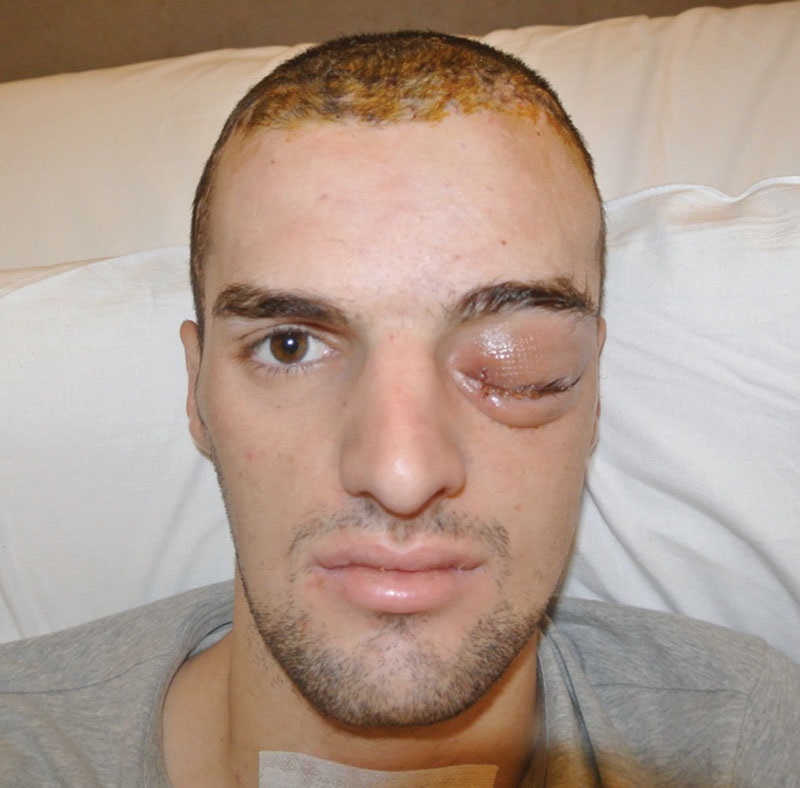A Case of a Survivor to a Through-and-Through Head Gunshot Wound following Russian Roulette
Sir:
Georges Arthur Surdez (1900 to 1949) is considered the inventor of Russian roulette. The first report of Russian roulette was published in January 30, 1937, in Collier’s magazine. In the original “game to die,” in 1917, in Romania, some Russian officers removed a cartridge from a revolver, spun the cylinder, snapped it back in place, placed the weapon to their head, and pulled the trigger.
Originally, the game was played with the intention of dying, because the Russian ranks were suffering many losses on the war front and were also impressed by the horrors of war. Thus, they actually played to die in order to clamp down their internal tragedy.1,2 Nowadays, Russian roulette is played with just one bullet, thus increasing the survival rate and turning it into a “game to survive” rather than a game in which to die. Nevertheless, both games have a common foundation in profound internal discomfort.3
At the end of October of 2013, a 20-year-old Albanian boy was recovering in our hospital following serious self-inflicted craniofacial trauma suffered while playing Russian roulette with a friend using a 0.22-caliber revolver. The police report describes the typical crime scene, with the drunk victim lying on the floor, one additional player, and a female figure who took flight and was then tracked down. Clinically, the patient presented a circled entry wound at the level of the right inferior border of the mandible and the exit wound at the level of the left frontotemporal region. The bullet passed through the head in a left-to-right direction, involving the floor of the mouth, the left maxillary bone, and the left orbital cavity, with traumatic orbital exenteration and cerebral frontal hernia (Fig. 1). The patient underwent tracheostomy and anesthesiology care for 10 days. Evoked potentials were present, and the electroencephalogram was normal. He underwent head and neck computed tomographic scanning showing extensive damage involving the frontal and temporal lobes (Fig. 2). He underwent surgery performed by neurosurgeons, maxillofacial surgeons, and an ophthalmologist. The patient was still alive, in good condition, and was discharged to home after 30 days (Fig. 3).


Today, Russian roulette is simple: typically, two players are involved, a single bullet is loaded into a six-shooter revolver, and then the cylinder is spun and randomly slapped closed. The first player puts the muzzle to his head and pulls the trigger. If the chamber is empty and the player survives, the sequence is repeated for the second player and it goes on until one of them, who is left alive, wins. By a simple Internet search using the Google search engine, we can find written instructions on how to play, slides showing the game step-by-step, and vocal instructions for blind persons. To the best of our knowledge, this is the first man surviving a through-and-through head gunshot wound suffered while playing Russian roulette. Most articles in the literature focus on the physiologic, social, and forensic aspects of patients who died while playing with their life. Only one other survivor from Italy has been described, with trauma involving the lower and midface that was successfully reconstructed.4
Original Source
PATIENT CONSENT
The patient provided written consent for the use of his images.
DISCLOSURE
The authors have no conflict of interest to report and did not receive any funding for this article.
Tommaso Agostini, M.D.
Francesco Arcuri, M.D.
Raffaella Perello, M.D.
Giuseppe Spinelli, M.D.
Department of Maxillofacial Surgery
CTO-AOUC
University of Florence
Florence, Italy
REFERENCES
1. Surdez G. “Russian roulette.” Collier’s Illustrated Weekly. 1937 Oxford English Dictionary
2. Shneidman ES. The psychological autopsy Suicide Life Threat Behav. 1981;11:325–340
3. Stack S, Wasserman I. Social and racial correlates of Russian roulette. Suicide Life Threat Behav. 2008;38:436–441
4. Di Benedetto GM, Grassetti L, Forlini W, Bertani A. A peculiar case of oral firework explosion caused by Russian roulette. Plast Reconstr Surg. 2009;124:172e–173e
